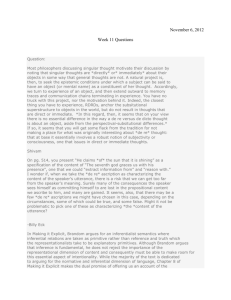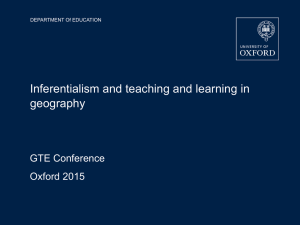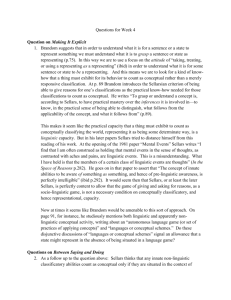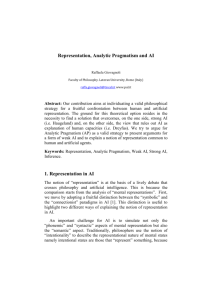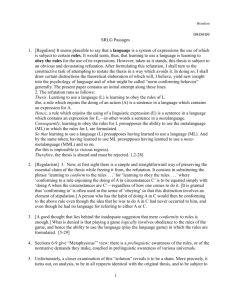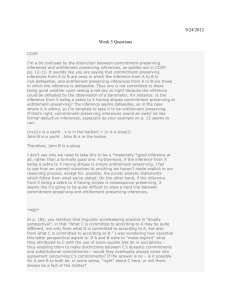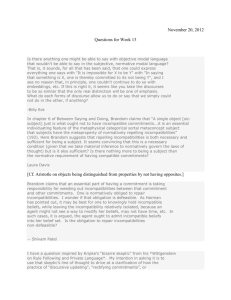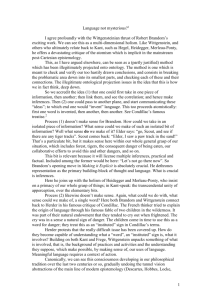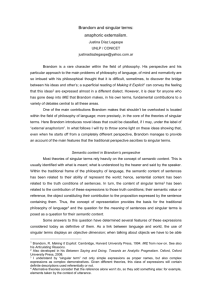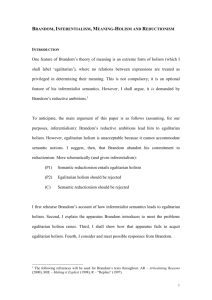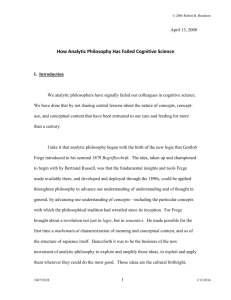Week ten questions
advertisement
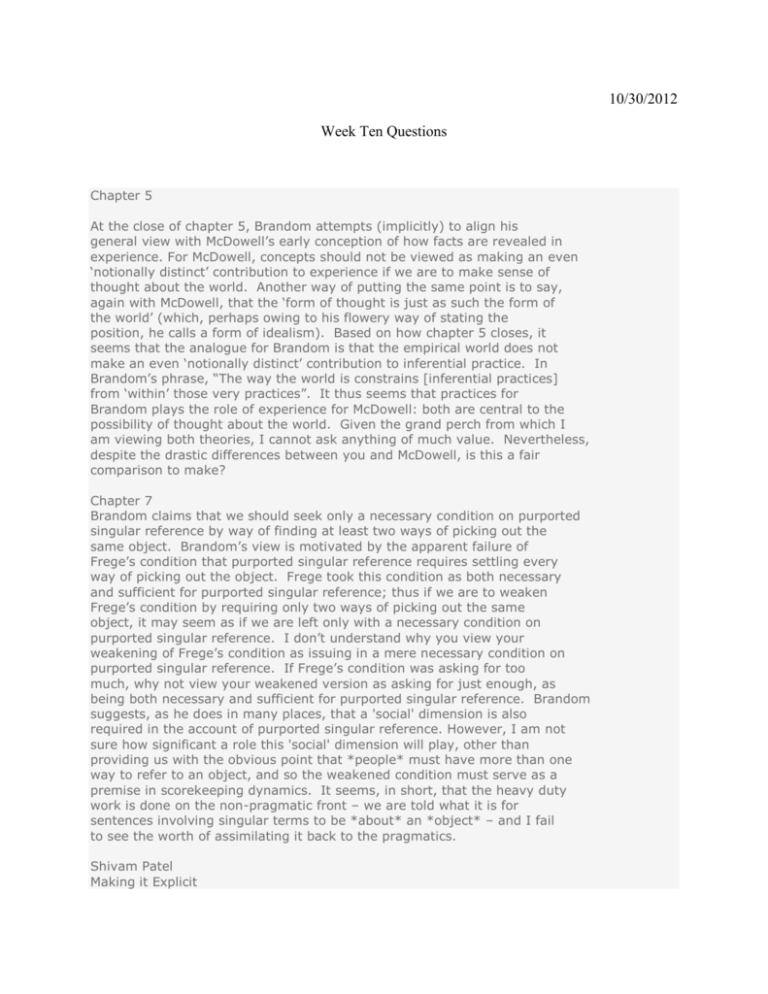
10/30/2012 Week Ten Questions Chapter 5 At the close of chapter 5, Brandom attempts (implicitly) to align his general view with McDowell’s early conception of how facts are revealed in experience. For McDowell, concepts should not be viewed as making an even ‘notionally distinct’ contribution to experience if we are to make sense of thought about the world. Another way of putting the same point is to say, again with McDowell, that the ‘form of thought is just as such the form of the world’ (which, perhaps owing to his flowery way of stating the position, he calls a form of idealism). Based on how chapter 5 closes, it seems that the analogue for Brandom is that the empirical world does not make an even ‘notionally distinct’ contribution to inferential practice. In Brandom’s phrase, “The way the world is constrains [inferential practices] from ‘within’ those very practices”. It thus seems that practices for Brandom plays the role of experience for McDowell: both are central to the possibility of thought about the world. Given the grand perch from which I am viewing both theories, I cannot ask anything of much value. Nevertheless, despite the drastic differences between you and McDowell, is this a fair comparison to make? Chapter 7 Brandom claims that we should seek only a necessary condition on purported singular reference by way of finding at least two ways of picking out the same object. Brandom’s view is motivated by the apparent failure of Frege’s condition that purported singular reference requires settling every way of picking out the object. Frege took this condition as both necessary and sufficient for purported singular reference; thus if we are to weaken Frege’s condition by requiring only two ways of picking out the same object, it may seem as if we are left only with a necessary condition on purported singular reference. I don’t understand why you view your weakening of Frege’s condition as issuing in a mere necessary condition on purported singular reference. If Frege’s condition was asking for too much, why not view your weakened version as asking for just enough, as being both necessary and sufficient for purported singular reference. Brandom suggests, as he does in many places, that a 'social' dimension is also required in the account of purported singular reference. However, I am not sure how significant a role this 'social' dimension will play, other than providing us with the obvious point that *people* must have more than one way to refer to an object, and so the weakened condition must serve as a premise in scorekeeping dynamics. It seems, in short, that the heavy duty work is done on the non-pragmatic front – we are told what it is for sentences involving singular terms to be *about* an *object* – and I fail to see the worth of assimilating it back to the pragmatics. Shivam Patel Making it Explicit Chapter 7 Brandom argues that it is substitution-inferential triangulation which gives us our “cognitive grip on objects in general” (431) where substitutional triangulation picks out objects and structures the content of singular terms while inferential triangulation structures the content expressed by sentences. On this inferentialist conception of meaning, representational purport of singular terms can be determined by their substitution-inferential significance. In other words, representational purport consists in specifying the relevant class of canonical designators for a term. However, it seems as though this model would not be sufficient to uniquely determine representational purport. It seems possible that more than one differing canonical designator can satisfy this criteria in a multitude of cases. Further, this worry seems to apply not only to the extension of the representational purport, but to its intension as well. Brandom argues we can proceed from inferential significance to extension through substitution-inference commitments and that we can also move from inferential significances to intensions through relativizing these significances to one’s collateral commitments. Consequently I am unsure if Brandom’s substitution-inferential triangulation is enough to capture representational purport or if something important is lost on this model. Chapter 5 Brandom gives a deflationary account of truth arguing that ‘truth’ and ‘refers’ are not explanatory but merely expressive. Truth and reference must be taken as expressive since, as Brandom argues, these notions presuppose propositional content and can therefore not be used to explain the very propositional content which it must presuppose. ‘Truth’ and ‘reference’ are consequently not primitive notions, but instead inherit their meaning through anaphoric antecedents. However, unlike traditional representational vocabulary, on Brandom’s inferentialist model, one is able to explain the practical significance of our discursive practices and consequently the propositional contents expressed without using notions of truth conditions or facts. Their significance, Brandom argues, can be explained in terms of the social practice of giving and asking for reasons. However, it seems as though here Brandom might face the same challenge as the representationalist. Although Brandom is not required to explain our discursive practices in terms of truth, he is required to explain our practices and the contents they express in terms of norms. These norms, it seems, presuppose content in similar manner as truth was taken to presuppose content. Although Brandom might respond that these norms are merely implicit in practice whereas truth is explicit, I do not see how Brandom is not subject to a similar challenge as the one he poses to the traditional semantic version of truth. Laura Davis
